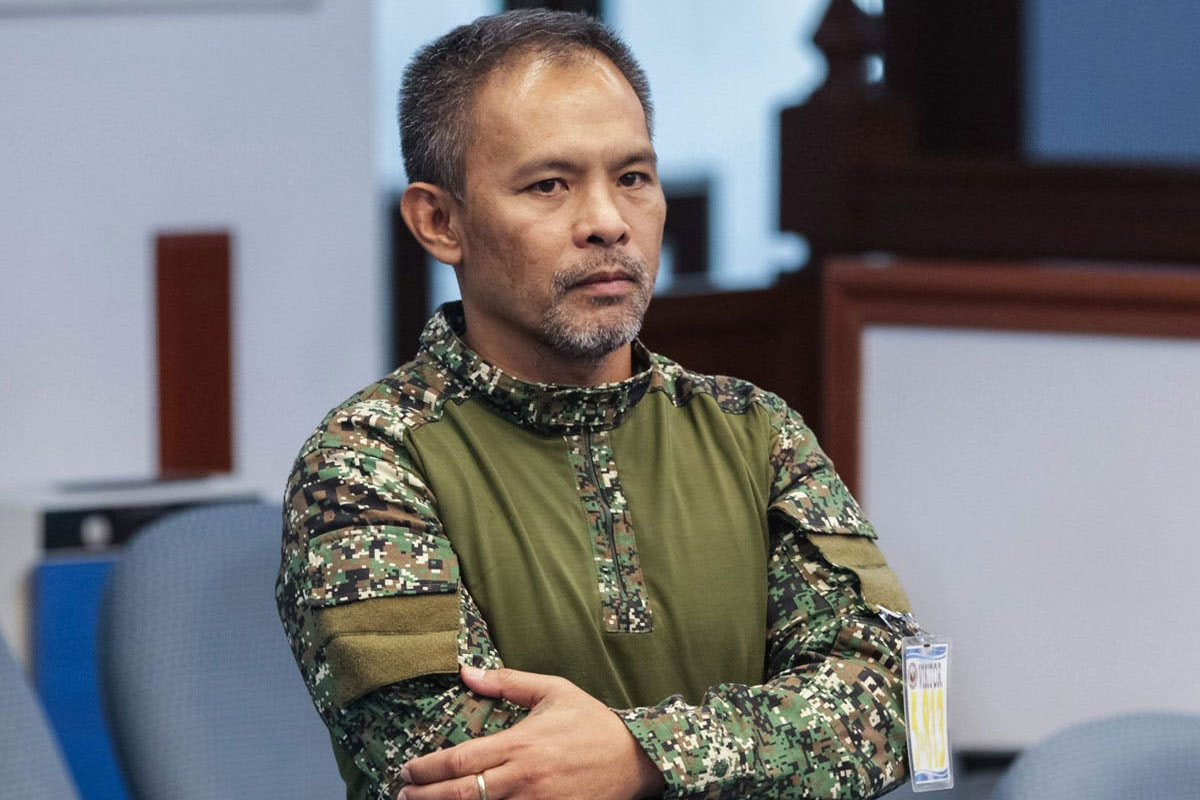 Commandos from the elite PNP Special Action Force (PNP-SAF) pray before resuming their mission to find the missing Cessna plane and its six passengers in the forest of Divilacan, Isabela.
Commandos from the elite PNP Special Action Force (PNP-SAF) pray before resuming their mission to find the missing Cessna plane and its six passengers in the forest of Divilacan, Isabela.
Gov’t not giving up on Cessna passengers
Rescuers continue search for missing crash victims, including 10-year-old, despite threats
TWELVE days after a Cessna plane carrying six people went down in the Sierra Madre mountains, government search-and-rescue teams on Saturday continued their massive efforts to find the missing aircraft with officials praying for a miracle they would still manage to find survivors of the crash.
Members of the Philippine National Police Special Action Force (PNP-SAF), Philippine Army (PA), Bureau of Fire Protection (BFP) and the Isabela Provincial Disaster Risk Reduction Management Office have not stopped their efforts despite the problems they have been encountering to reach the suspected crash site, foremost of which is the unpredictable weather, cold temperature, torrential rains and presence of wild animals including poisonous snakes.
There is also the threat posed by members of the New People’s Army who are known for attacking soldiers and policemen engaged in humanitarian missions, thus the need for the search-and-rescue teams to be on constant alert for armed men in the area.
“We’re monitoring the activities of our search-and-rescue teams round-the-clock and have been providing them all the equipment and other necessary support they need in this delicate mission,” said PNP-SAF director, Brigadier General Edgar Alan O. Okubo.
Just like his counterparts, Okubo said they are hoping and praying that rescuers would reach the site and find survivors. “We’re praying for a miracle here and we won’t stop until we locate the missing plane,” the PNP-SAF director said.
Atty. Constante A. Foronda, head of the Isabela PDRRMO and incident commander of the SAR team, vowed to exert all efforts to find the aircraft and its pilot and passengers.
“Hindi kami susuko, hindi kami titigil. Ang sabi ko nga sa nanay ng dalawa sa mga missing, alam mo ang turing ko sa mga anak mo ay parang anak ko na din na kailangang hanapin at iligtas ko,” a teary-eyed Foronda said in a television interview.
He was referring to the missing 10-year-old passenger.
CRASH EXPOSES NEED TO IMPROVE GOV’T RESCUE EFFORTS
As commandos from the PNP-SAF, the Army and members of the Isabela PDRRMO continued their effort to find the missing victims in the heavily-forested areas between Divilacan and Maconacon in Isabela province, the January 23 plane crash has exposed the need for the government to better prepare when responding to similar tragic incidents in the future.
There have been suggestions to have an inter-agency unit that will supervise all search-and-rescue efforts in the event of an air, land or a maritime tragedy, equipped with planes, helicopters and watercrafts badly needed to ferry rescuers at the soonest possible time.
The lack of resources has been evident in the Cessna plane incident in Isabela. Although there were reports that the most possible crash site is located between Barangays Sapinit and Dicaruyan in Divilacan municipality, rescuers are yet to reach the site 12 days after the plane went missing after leaving Cauayan Airport in Isabela in the afternoon of January 23.
Consider this: the search was actually delayed for three days due to inclement weather; the unavailability of planes or seacrafts that would transport the SAF commandos and their equipment to the nearest command center; the presence of heavy clouds that make it very hard for helicopter or plane crews to spot signs of the plane wreckage; the lack of roads that make it much harder for the rescuers to reach their target and other unforeseen circumstances.
There is also negative Globe, radio, internet and SatPhone signal in the area which is known for being heavily-vegetated and for having a foggy, rainy weather. Smart signal in the same area is also on and off.
Efforts to reach the place via off-road vehicles have also been futile since the vehicle routes in the area have been heavily-damaged by landslides, meaning only motorcycles or ‘habal-habals’ can only pass thru it. Officials said the help of barangay officials and local residents is also crucial in the search since people who may have witnessed the plane crashing to the ground can easily provide rescuers with timely and accurate information, provided they have the tools to do it.
Last but not the least, there is a need to provide the unit with adequate funding since the conduct of a search-and-rescue operation is very expensive. Officials said that food and other provisions as well as gasoline and aviation fuel cost reach hundreds of thousands a day.
Atty. Foronda said their efforts have been boosted by the arrival of the SAF commandos who are highly-trained in combing heavily-forested areas and are equipped with sound detectors, tactical stretchers, drones and other necessary equipment.
At least 54 SAF troopers are involved in the mission, separately ferried from Cauayan Airport to Maconacon by Air Force helicopters of private Cessna planes.
From Divilacan alone, the rescuers have to endure a six to eight hours long sea travel to reach the command center.
The arrival of the rescuers have been greatly delayed by bad weather, said Foronda.
“I would like to thank the members of our initial rescue teams. Sabi nila, sobrang lamig, maulap, mahangin, maginaw masyado sa area. Merong iba nagpapatuloy at yung mga nakapagpahinga na, lalarga na naman, start from Square 1. Lahat ginagawa nila kahit mahirap, yungi mposible ginagawa nilang possible,” the official said.
SAF troopers from the 151st Special Action Company and 18 others from the SAF Rapid Deployment Battalion left the SAF headquarters in Camp Bagong Diwa in Bicutan, Taguig City to Ilagan City in Isabela last week to join the conduct of search ,rescue and recovery operations in the province.
The PNP-SAF commandos are not taking any chances since the place is known for having a considerable large presence of NPA rebels and has been the scene of major gunbattles between government troops and the rebels since the 70s and 80s.
Around 12 noon last Monday, the SAF commandos arrived at the SAF headquarters in Camp Samal in Bgy. Arcon, Tumauini municipality where they were placed on standby pending their actual insertion in the purported crash site.
As planned, the SAF commandos were inserted in the area from the Maconacon Airport in Isabela by a PNP chopper on orders of PNP chief, General Rodolfo S. Azurin Jr.
Last week, one problem that confronted the SAF rescue team is the fact that it will take six to seven days to reach the suspected crash site by foot since the last passable road for transport vehicles is in San Mariano municipality. A sea travel on the other hand will take at least half-a =day.
Thus, the PNP-SAF requested for a police chopper to move forward to Isabela to bring the much-needed supplies and other provisions including batteries, dry rations and fuels as well as the equipment needed by the SAF commandos as they search the thick forest in the area.
The Philippine Army has also dispatched three search-and-rescue teams from the 95th Infantry Battalion and 5th Infantry Division to help in the ongoing search-and-rescue mission.
Maj. Gen Okubo said that of all the responding units, only the SAF commandos ventured to reach the area through numerous modes of transport that is by air, by land and by sea.
He said that he is contemplating to send his men from Buguias, Mountain Province—commandos who are known to have acclimatized themselves to very cold weather—in the event the search yield negative result next week.
The PNP-SAF commandos are also getting help from the Police Regional Office 2 headed by Brig. Gen. Percival A. Rumbaoa.
As of yesterday, officials said there is a very low chance that the missing plane will be discovered at sea because the phones of the missing passengers still have been ringing.
This has prompted the PNP-SAF to ask their Army counterparts to set-up their radio communication in case of an emergency.



















